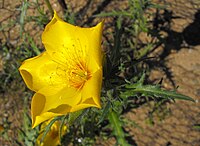
Photo from wikipedia
The global distribution of exotic species is the result of abiotic, biotic and dispersal filtering processes that shape the movement and success of species outside their native range. In this… Click to show full abstract
The global distribution of exotic species is the result of abiotic, biotic and dispersal filtering processes that shape the movement and success of species outside their native range. In this study we aim to understand how these filtering processes drive the fluxes of grass species among regions, the factors that influence which species establish outside of their native range, and where they do so. We used national and subnational checklists of native and introduced grass species to determine the extent to which each region was a source or recipient of exotic grass species. We asked how species traits may distinguish those grass species that have naturalized outside their native range from those that have not, and how environmental conditions are related to the distribution of exotic grass species. We found that exotic grass establishment is shaped by an array of factors including characteristics of regions, traits of species and their interactions. Regions with a longer history of human occupation and larger numbers of native grass species were generally the most important sources of exotic species. Global flows of species were mostly driven by a climate match between the native and exotic ranges, but were also highly asymmetric, with regions with recent human arrival being the major hosts of exotic grass species. Tall, annual and C4 grass species exhibited particularly high probabilities of establishment outside their native range. Despite the idiosyncrasy and stochasticity characteristic of exotic species establishment, this biogeographical analysis revealed important generalities across this large plant group. Our results suggest that grass species that have co-occurred with humans for a longer time may be better adapted to living in anthropogenic landscapes, explaining the global asymmetry in species introductions.
Journal Title: Ecography
Year Published: 2020
Link to full text (if available)
Share on Social Media: Sign Up to like & get
recommendations!